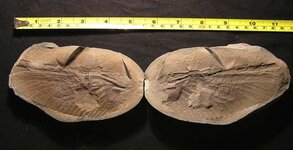- Joined
- Nov 19, 2002
- Messages
- 3,031
Please join me here in congratulating Andy Tenny (Neuropteris) on an amazing achievement. Andy has found a fossil wing from a Carboniferous insect that has just been published; not only is it a new species, but is a whole new genus too. One of our very own members has thus contributed greatly to our understanding of insect evolution!
Andy's discovery and description of the insect Anglopterum magnificum is detailed in this online pdf paper:
http://fossilinsects.net/pdfs/Prokop_etal_2006_CRPalevol_HomoiopteridsCarbonEngland_preprint.pdf
Anglopterum magnificum was a member of the palaeodictyopterida, the only insect order to have evolved that became completely extinct and left no living descendants. This huge flying insect had four wings and a wingspan of 30cm or so. With a beak which it probably used to suck sap from plants, it would have looked have somewhat akin to a huge vegetarian dragonfly with a pointed proboscis. The reconstruction below is of a similar insect, Stenodictya, which gives a rough impression of what Andy's insect would have looked like.
In Bits and Pieces Andy wrote:
Well, once again, congratulations Andy. You are an inspiration to fossil collectors everywhere!!!!!



Andy's discovery and description of the insect Anglopterum magnificum is detailed in this online pdf paper:
http://fossilinsects.net/pdfs/Prokop_etal_2006_CRPalevol_HomoiopteridsCarbonEngland_preprint.pdf
Anglopterum magnificum was a member of the palaeodictyopterida, the only insect order to have evolved that became completely extinct and left no living descendants. This huge flying insect had four wings and a wingspan of 30cm or so. With a beak which it probably used to suck sap from plants, it would have looked have somewhat akin to a huge vegetarian dragonfly with a pointed proboscis. The reconstruction below is of a similar insect, Stenodictya, which gives a rough impression of what Andy's insect would have looked like.
In Bits and Pieces Andy wrote:
Some might remember this from a post some time ago - back in 2004 I found this eye popping beastie in my local opencast coal mine. Was pottering about one sunday morning when I noticed a likely looking nodule had dropped from a block of mudstone that had been sitting on the tips for weeks. Thinking it might contain a nice fern or cone I gave it a tap and was gobsmacked by what appeared. Its now been described and not only is it a new species its a new genus! Anglopterum magnificum or Englands Magnificent Wing if my latin is correct. The paper "New homoiopterids from the Late Carboniferous of England (Insecta:Palaeodictyoptera)" is available on the web as a pdf file - google "Crock Hey" and it should be one of the first things to pop up. We're talking about a fly with a wingspan of about 30cm here. I am somewhat chuffed!
Well, once again, congratulations Andy. You are an inspiration to fossil collectors everywhere!!!!!







 congrats Andy!
congrats Andy!